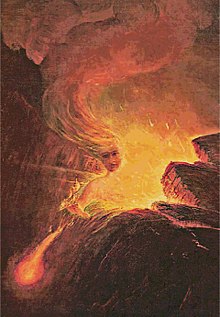Pele (goddess)

Pele is a fire and volcano goddess in Hawaiian mythology . It plays an important role in the extensive polytheistic hierarchy and is also very well known in contemporary Hawaii. She is often spoken of respectfully as "Madame Pele" or "Tūtū Pele". As the goddess of the volcanoes, she is considered a creator and destroyer.
Legends
After the legend, her father sent her from Kahiki ( Tahiti continued) because she was short-tempered and her older sister Namaka (or Namaka-o-Kaha'i ), the goddess of the sea, fought. In a canoe that she got from her eldest brother Kamohoaliʻi (the king of the sharks), she left her original homeland and came to Hawaiʻi , where she created volcanoes on various islands with her magic wand pāoa . Her sister Na-maka-o-Kaha'i followed her and fought her with the water available to her. As the goddess of the volcanoes, she is considered a creator and destroyer.
A great battle broke out on the slopes of Haleakalā on Maui , in which Pele apparently lost and was mourned by her family. But when the victorious Na-maka-o-Kaha'i looked back on her return, she could tell from the rising smoke that Pele had again started her volcanic fire on the island of Hawaii, and she gave up the fight.
Pele found her final residence in the Halemaʻumaʻu crater , which is located within the caldera of Kīlauea . Further legends describe her love affairs and fights with Kamapuaʻa , the quarrel with Poliʻahu , the snow goddess of Mauna Kea , as well as numerous other traditions.
Pele as the namesake
Various Volcanological phenomena were named after her, like the hair of Pele , the tears of Pele and the seaweed of Pele ( limu o Pele ). A large volcano on the moon Io on the planet Jupiter also bears her name. An asteroid was also named after her: the asteroid (2202) Pele .
literature
- Martha Beckwith: Hawaiian Mythology . Yale University Press, New Haven 1940
- Hans Nevermann: Gods of the South Seas. The Polynesian religion. Stuttgart 1947.
Individual evidence
- ↑ cf. Martha Beckwith: Hawaiian Mythology . Yale University Press, New Haven 1940: The Pele Myth , The Pele Sisters , Pele Legends , Kamapuaʻa
- ↑ Patricia 'Iolana: TuTu Pele: The Living Goddess of Hawaii's Volcanoes . In: Sacred History . 2006.
- ↑ see Namaka (Eng.)
- ↑ see pāoa in Hawaiian Dictionaries
- ^ WD Westervelt: Hawaiian Legends of Volcanoes . GH Ellis Press: Boston 1916. p. 6. cf. How Pele came to Hawaii
- ^ WD Westervelt: Hawaiian Legends of Volcanoes . GH Ellis Press: Boston 1916. p. 64. cf. Genealogy of the Pele Family
- ^ WD Westervelt: Hawaiian Legends of Volcanoes . GH Ellis Press: Boston 1916. pp. 11f. see. How Pele came to Hawaii
- ^ WD Westervelt: Hawaiian Legends of Volcanoes . GH Ellis Press: Boston 1916. p. 23. cf. The Hills of Pele
- ^ WD Westervelt: Hawaiian Legends of Volcanoes . GH Ellis Press: Boston 1916. cf. Pele and Kama-Puaa
- ^ WD Westervelt: Hawaiian Legends of Volcanoes . GH Ellis Press: Boston 1916. cf. Pele and the Snow Goddess
Web links
- Dancing Pele , photo of a Mauna Loa lava flow by the late volcanologist Katia Krafft
